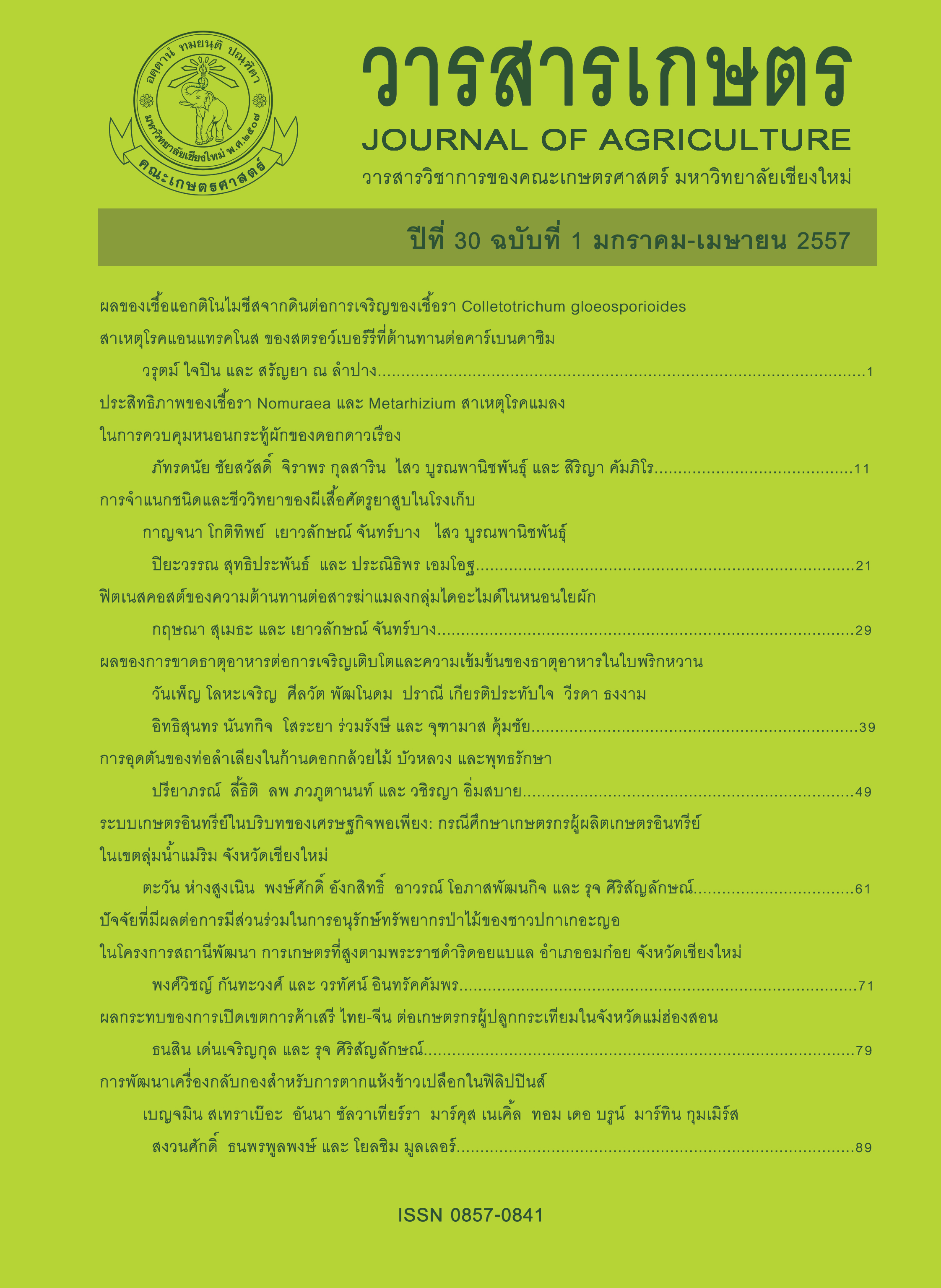ระบบเกษตรอินทรีย์ในบริบทของเศรษฐกิจพอเพียง: กรณีศึกษาเกษตรกรผู้ผลิตเกษตรอินทรีย์ในเขตลุ่มน้ำแม่ริม จังหวัดเชียงใหม่
Main Article Content
บทคัดย่อ
การวิจัยนี้มีวัตถุประสงค์เพื่อศึกษาการผลิตในระบบเกษตรอินทรีย์ของเกษตรกรในเขตลุ่มน้ำแม่ริม ด้านการบริหารจัดการฟาร์ม ปัจจัยที่มีผลต่อการปรับเปลี่ยนวิถีการผลิตจากเกษตรเคมีสู่เกษตรอินทรีย์ และศึกษาผลของการปฏิบัติตามแนวทางเกษตรอินทรีย์ที่มีต่อการดำเนินชีวิตตามแนวทางเศรษฐกิจพอเพียงตลอดจนกำหนดกรอบคำอธิบายเชิงทฤษฏีเพื่ออธิบายการมีชีวิตที่พอเพียงของเกษตรกรผู้ผลิตในระบบเกษตรอินทรีย์ในเขตลุ่มน้ำแม่ริม ประชากรที่ใช้ในการศึกษามีจำนวนทั้งสิ้น 112 คน จากข้อมูลของเครือข่ายที่ส่งเสริมเกษตรอินทรีย์ในพื้นที่
ผลการวิจัยพบว่าลุ่มน้ำแม่ริมเป็นลุ่มน้ำที่มีการทำการผลิตในระบบเกษตรอินทรีย์แหล่งใหญ่ ของจังหวัดเชียงใหม่ ซึ่งมีพื้นที่เกษตรอินทรีย์รวมประมาณ 692.28 ไร่ คิดเป็นร้อยละ 1.04 ของพื้นที่ทำการเกษตรทั้งลุ่มน้ำ มีรูปแบบการจัดการฟาร์ม 2 รูปแบบ คือเกษตรอินทรีย์ในระบบเกษตรผสมผสาน เกษตรอินทรีย์ในระบบเกษตรเชิงเดี่ยว นอกจากนี้ยังพบว่าการทำเกษตรอินทรีย์ของเกษตรกรมีผลอย่างมากต่อการดำเนินชีวิตตามแนวทางเศรษฐกิจพอเพียงของเกษตรกรที่ผลิตในรูปแบบเกษตรอินทรีย์ในประเด็นต่าง ๆ อาทิ ความพอเพียงด้านจิตใจ สังคม เศรษฐกิจ สิ่งแวดล้อม และเทคโนโลยี ในระดับที่สูง ทั้งนี้เพราะเกษตรกรที่ทำเกษตรอินทรีย์ส่วนใหญ่สามารถพึ่งตนเองได้ในด้านอาหาร และปัจจัยการผลิต ถึงแม้ข้อมูลด้านเศรษฐกิจที่ค้นพบ จะระบุว่าเกษตรกรจะมีรายรับที่ต่างจากรายจ่ายไม่มากนักก็ตาม แต่เกษตรกรส่วนใหญ่ยังคงเชื่อมั่นว่าระบบเกษตรอินทรีย์จะทำให้อยู่รอดได้ ทั้งนี้เนื่องจากหลักในการวิเคราะห์ความพอเพียงของเกษตรกรในพื้นที่ ผู้วิจัยได้ใช้หลักความสามารถในการพึ่งตนเอง เป็นพื้นฐานในการวิเคราะห์ นอกจากนี้ยังพบว่าเกษตรกรที่ยอมรับแนวพระราชดำริเศรษฐกิจพอเพียงไปปฏิบัติพบว่าส่วนใหญ่เกิดจากความเชื่อและศรัทธาในพระบาทสมเด็จพระเจ้าอยู่หัว รองลงมาเกษตรกรเชื่อว่าแนวทางเศรษฐกิจพอเพียง จะช่วยให้สามารถลดรายจ่ายในด้านปัจจัยการผลิต และปัจจัยในการดำรงชีวิตประจำวันได้ โดยมีปัจจัยเอื้อที่ทำให้เกษตรกรสามารถตัดสินใจในการดำเนินชีวิตตามแนวทางเศรษฐกิจพอเพียงที่สำคัญ อาทิ ความพร้อมด้านฐานะทางเศรษฐกิจของเกษตรกร ความสามัคคีในครอบครัว ที่ตั้งฟาร์มและแหล่งน้ำ ส่วนประเด็นที่เป็นอุปสรรค คือเรื่องภาระหนี้สิน ความยากจน ความร่วมมือของคนในครอบครัว และนิสัยส่วนตัวของเกษตรกร
Article Details
เอกสารอ้างอิง
ตะวัน ห่างสูงเนิน. 2546. เกษตรผสมผสานทางเลือกและทางรอดของสังคมไทย. พงษ์สวัสดิ์การพิมพ์. เชียงใหม่. 125 หน้า.
----------------------. 2549. ข้าวอินทรีย์. พงศ์สวัสดิ์การพิมพ์. เชียงใหม่. 56 หน้า.
วิชัย สรพงษ์ไพศาล สมชาย ธนสินชยกุล วงค์พันธ์ พรหมวงค์ ฉัตรมณี วุฒิสาร และภราดร ดอกจันทร์. 2554. ความหลากชนิดของแมลงศัตรูข้าวและศัตรูธรรมชาติในนาข้าวอินทรีย์. วารสารเกษตร 27(1): 39-48.
วิฑูรย์ เลี่ยนจำรูญ. 2539. พัฒนาการเกษตรกรรมทางเลือก.19-62. ใน: วิฑูรย์ เลี่ยนจำรูญ, (บก.) เกษตรกรรมทางเลือก ความหมาย ความเป็นมา และเทคนิควิธี. สำนักพิมพ์พิมพ์ดี, กรุงเทพฯ.


